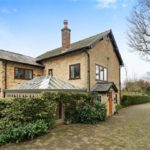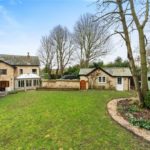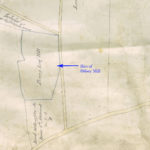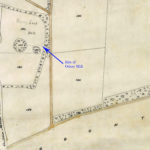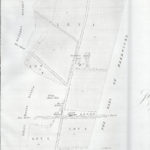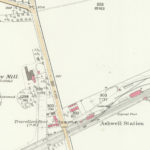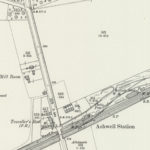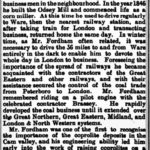Odsey Mill
One has to wonder what prompted Herbert Fordham to erect a brick and timber built corn mill on the edge of a field known as Penny Loaf. the mill and adjacent yard were set back from Odsey Way and within the hamlet we know today. Perhaps, good access by road, both to bring in grain and to take out flour, influenced the decision. Or was Herbert planning ahead? He was one of the promoters of a local railway line to run from Hitchin to Royston passing through Odsey. The Act for the Hitchin-Royston Railway received Royal Assent on 16 July 1846 and that was the very year he built his new mill, which was steam powered.
The railway duly opened in October 1850, cutting across Odsey Park, which was owned by the Fordham family, although Cheyney Manor owned by Lilley and the Earl of Hardwicke also ceded land. A station was built at Odsey, standing amidst fields and just down the road from the mill.. There were few local residents or other businesses to use the new station, other than the family and staff at Odsey Park. Otherwise the nearest centres of population able to make use of it, were Ashwell, Steeple Morden & Guilden Morden and across the Icknield Way lay Sandon, Kelshall and Therfield., with rather a hike over the hills.
Over time corn milling became less attractive compared with the new “crop” being dug from the ground in the north of the parishes of Ashwell, Guilden Morden & Steeple Morden. This was coprolites the fossilised remains of creatures, such as dinosaurs and molluscs from millions of years ago. It is sometimes said they are specifically the fossilised faeces of dinosaurs, but that begs the question of how the beasts managed to deposit their faeces in specific, self-contained bands in the ground, simply not realistic, so they mot have been created more widely. The key feature of coprolites is that ground into granules and powder and mixed with sulphuric acid, they became phosphate rich fertilizer, which could be easily spread on agricultural land.
Hebert Fordham set to, converting his mill into a coprolite mill. This was probably around 1856-58. On the 1859 map prepared for the sale of the Cheyney Manor Estate refers to Odsey Steam Mills, which may suggest that conversion had taken place. By 1863 Herbert Fordham was described as of Odsey Mills, Manure & Coprolite Works and appears in similar fashion in 1872 & 73, when the business description includes Artificial Manure Manuufacturer.. The heady days of coprolite production was the 1960s and 70s and the volume much reduced in the 1880s. The mill may have become little used at this time and, with the death of Hebert Fordham in 1891, the family turned it into a meeting place, taking down the much of the buildings that did not lend themselves to such use. The 1903 25 inch OS map shows a much reduced footprint, compared with 1888. The conversion to the Mill Rooms having been completed in 1892. It was used widely by for religious gatherings, political meetings and social gatherings. It was effectively Odsey village hall.
In 1960 the Fordham family converted the Mill Rooms into a private house, which was let for a number of years and they subsequently sold the freehold in 1978. The house still stands today and is known as Mill House, 106 Station Road, Odsey.
Photographs & Maps
Newspaper Reports
Last Updated on October 27, 2024

